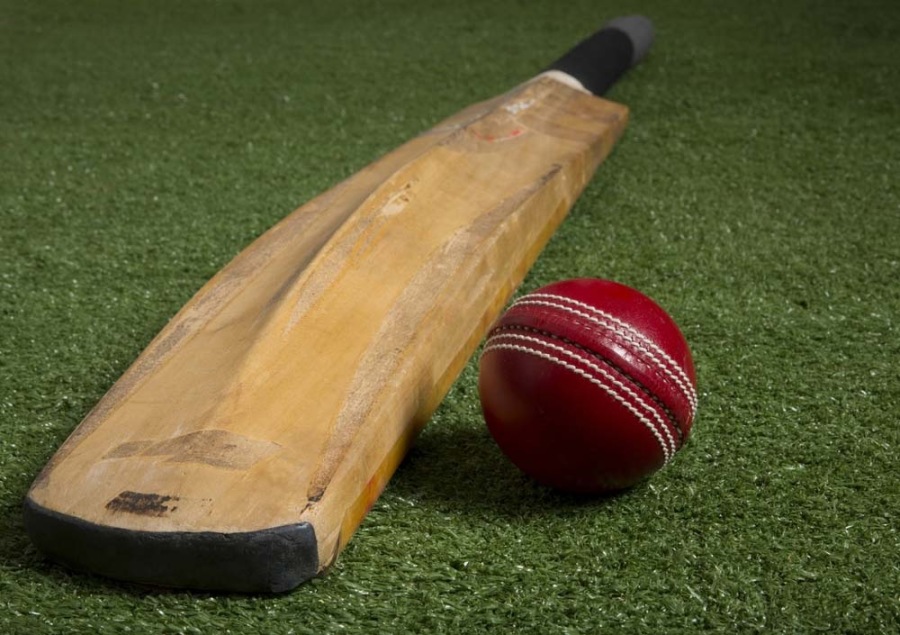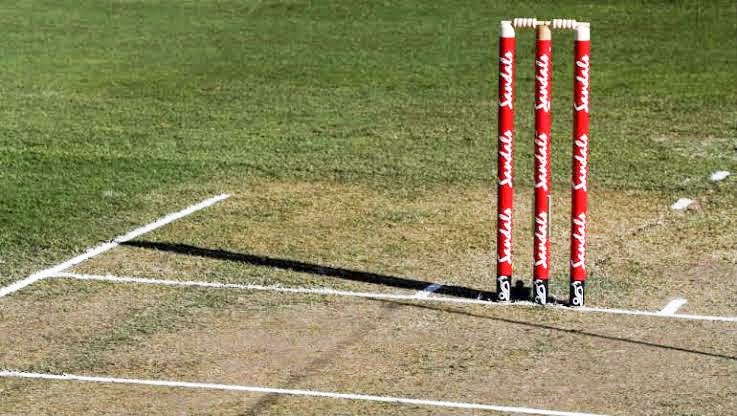The Sound of Leather on Willow

"I don't like cricket, oh no,Now I know that cricket isn't everyone's cup of tea, but, be that as it may, cricket, according to the greatest sports commentator of all, Wikipedia on History of Cricket, is undoubtedly the "world's second most popular spectator sport after association football". This latter round-ball-kicking sport is of course what everyone else, who doesn't play it, calls soccer.
I love it."10cc and Dreadlock Holiday
So why is cricket so maligned, even in countries where it is revered by so many? Is it perhaps that the rules of this virtually religious cult game, original dreamed up by the Poms, are so complex as to be totally incomprehensible to the rest of the world, or is it simply that it's treated by non-participants as a form of magical Juju dance? Certainly, when the eleven fielders, two batsmen and two umpires come marching out onto the oval, there is a certain mystique involved in the due process of preparing for play.
Incidentally, I have heard it said, particularly by non-cricket enthusiasts, that the game was invented by the Poms, who are not a particularly spiritual people, in order that they may have some conception of eternity.

Three identical stumps of wood are inserted vertically at either end of the pitch (which is a specially short-mowed and rolled, linear section in the middle of the oval) with two horizontal bails placed atop each set of stumps. These wooden accoutrements (three stumps and two bails in total) are referred as the wicket, or sometimes just as the stumps. Essentially the game proceeds with a few specially preselected players on one side taking it in turns to bowl six times from one set of stumps to the other set of stumps, while the other side provides a batsman, with a traditional bat made from willow wood, who attempts to prevent the leather-bound ball from hitting the stumps.
There are actually two batsmen, one at each end of the pitch. The batsman defending his wicket from the hurling or spinning prowess of the bowler (see below), is referred as being 'on strike', no matter how active or docile he may appear to be, but rarely has any affiliation with union movements.
Sounds quite simple, doesn't it? In reality, however, the bowler comes from one of two main schools of practiced lunacy as follows:
- Pace Bowler - This fella, who is often long and lanky and fit as a fiddle, takes a long run up to one end of the pitch and lets fly with this hard leather ball at the batsman at the other end of the pitch, as fast and hard as he can, with the intention of getting him 'out'. This 'out' process can be achieved in several ways, such as (i) by the ball missing the batsman, his bat, his various fragile limbs, head and torso, and directly hitting the stumps and the bails with them; or (ii) by the batsman being fortunate enough to get bat on ball, after which one of the ten other players on the bowler's team, or indeed the bowler himself, actually catches said ball before it hits the ground; or (iii) by the batsman being run out (this occurs when ball hits bat then rebounds off in one or other direction without being caught, thus permitting the two batsmen, one at each end of the pitch, to run hell for leather between stumps, thus acquiring 'runs', and one player, any player, throws the ball to hit one of the sets of stumps before the batsman closest to that set of stumps can reach them) ... simple really; or (iv) by the batsman being hit 'leg before wicket' (when he is so careless as to have his spindly little legs prevent the ball from hitting the stumps); or (v) by being knocked senseless by a direct hit to the person and either being 'out for the count' or retiring hurt. The last example is rare indeed these days, as the batsmen wear protective pads to cover their spindly legs and knees, a helmet to protect their head, and a specially shaped guard, inserted down the inside of their pantaloons, to ensure that the lineage of future cricketers will continue. Incidentally, there is no such term as 'crown jewels before wicket', painful though it may be.
- Spin Bowler - This guy, who is often more podgy than lanky, and perhaps built more for comfort than speed, takes a much shorter run up than the pace bowler, and lets the ball fly from his grasp with much less whizzbang and gusto. He has, however, mastered the craft of spinning the ball with magical twists of his fingers, so that, once it bounces in front of the batsman, it will undoubtedly deviate from the original line, hopefully completely bamboozle the batsman, catch an edge off the bat and then, hopefully, be caught by one of the 'slips' or the 'wicketkeeper' (more on this later).
There are complications and exceptions to this general status, but, for simplicity and understanding, let's just say that each team must go all in until they're all out, twice, or until it rains.A batsman can, of course, be 'stumped', which means the ball has hit his wicket and he is 'out'. This does not mean that he has been on the turps the night before the game and he is consequently having difficulty thinking properly.

- Wicket Keeper - This is the man whose main purpose in cricket is to stop the ball from heading towards the boundary behind the batsman, should the latter fail to hit it, or should the ball fail to hit the wicket. Thus, the 'wicket keeper' is invariably the backstop, unless there is someone, doubtless renowned for having shapely lower limbs, playing at 'fine leg' (see top right of above diagram). Because the 'wicket keeper' invariably aims to catch most of the balls thrown at the stumps, he is given a pair of special gloves, to assist him in catching and to prevent him having to count his digits after each ball has been bowled (any broken ones are neatly retained inside said gloves). He is also duly fitted out with leg pads. As he often crouches with his legs open, he also wears protection to maintain the future lineage of wicket keepers. Contrary to common belief, the 'wicker keeper' is not responsible for taking the stumps and bails (ie wicket) home with him, tending to them, rubbing them with linseed oil and polishing then, unless he has a particular wood fetish.
- Slips - These are the guys standing very close to the 'wicket keeper', who are also chosen for their ball-catching prowess, and because they are good mates with the 'wicket keeper' and invariably enjoy a chat. There are, depending upon the fielding tactics, often more than one of then, in which case they are referred as 'first slip', 'second slip', etc, depending upon how close to (and hence well liked by) the 'wicket keeper' they are. This numerical order is not a tally with respect to how many times they've missed a catch, or fallen over on the wet grass, no matter how many such slips they may have made.
- Off side and On side, or Off side and Leg side - The terms 'off' and 'on' or alternatively 'off' and 'leg' are used before some fielding positions, to denote whether they are positioned on the batsman's right side (ie 'off' side) or the batsman's left side (ie 'on' or 'leg' side). This applies only to a right handed batsman. If the batsman is left handed then everything moves around and his 'leg' is still 'on', although it may be off if the fast bowler has anything to do with it. Cricket, being a gentleman's game, does not recognise the batsman's backside, even thought the 'wicket keeper' spends an inordinate amount of time staring at it.
- Deep or Long, Short and Silly - the terms 'deep' and 'long' are used to modify fielding positions further away from the batsman, with 'short' being closer to the batsman. These modifiers have no bearing whatsoever on the thinking prowess or height of the fielder. The term 'silly', however, is almost self explanatory, as this is applied to a fielder who is positioned very close to the batsman (eg 'silly point', 'silly mid-on') and hence becomes an easy target when the batsman hits the ball. Although he is given a helmet, he has no special gloves and hence, unlike the 'wicket keeper' invariably has to check the number of digits he retains in between balls bowled.
- Deep Backward Square Leg - I've specifically selected this fielding position as it is important to note that cricket is an amiable sport, played by gentlemen who bear absolutely no malice or discrimination towards either the mentally or physically handicapped. It should be recognised, however, that anyone who is regularly asked to play in this position (and hence close to the boundary) along with other boundary positions, such as 'fine leg', 'deep mid wicket', 'long-off', 'deep extra cover' or 'third man', should think long and hard about investing in some mints or breath fresheners.
....................<<..................>>...................

http://ken-boddie.squarespace.com
The author of the above, Ken Boddie, besides being a sometime poet and occasional writer, is an enthusiastic photographer, rarely leisure-travelling without his Canon, and loves to interact with other like-minded people with diverse interests.
Ken's three day work week (part time commitment) as a consulting engineer allows him to follow his photography interests, and to plan trips to an ever increasing list of countries and places of scenic beauty and cultural diversity.
Articles from Ken Boddie
View blog
Perhaps Scotty, the 7m high equine wonder, at this year's Boonah ‘Clydesdale Spectacular’ June show, ...

Introductory Geographic Lesson · I was tidying up some photographic files from a couple of years bac ...

It was hot … bloody hot! … yet here we were in the middle of the 'high dune' country, in the south o ...
Related professionals
You may be interested in these jobs
-
Solution consultant – Analyst programmer
Found in: Talent AU C2 - 4 days ago
Thirdera Melbourne, Australia Full timeThirdera is looking for a highly skilled Solution Consultant to join our team · Thirdera is a leading global ServiceNow partner changing the way companies experience the platform. How? By helping our clients unlock business and customer workflows in the cloud through digitizati ...
-
General Practitioner GP
Found in: Talent AU C2 - 4 days ago
Douglas Healthcare Sydney, Australia Full timeJob description: · GP desired for busy mixed billings clinic in the Bossley Park area. High foot traffic. RN support. GPs booked out daily Get in quick. · More details: · GP (FRACGP) desired to join a busy GP owned practice in the Bossley Park area. Due to strong patient growth - ...
-

FMW Developer
Found in: JobGet AU C2 - 15 hours ago
Experis ManpowerGroup Sp. z o.o. Canberra, AustraliaFMW Developer · Contract: 12 months · Extension: 12 months · Location: ACT · Clearance: Minimum Baseline · Duties: · Develop and deploy SOAP and REST services using Oracle Fusion Middleware products, such as Oracle Service Bus and SOA Suite components. · Utilise WSDL, WADL, Sw ...


Comments
Ken Boddie
4 years ago #30
Thanks, Prav, for filling in the blanks in my implication. 🤗
Ken Boddie
4 years ago #29
I accept that there have been many technical changes, Prav, what with Hawkeye, Hotspot, Snickimeter, but these are to assist in umpiring and are after the event of bowling and bat on ball. Furthermore they are only applied at elite level. At grass roots level, where the great predominance of cricket is played, on the beach, backyard, village green, schools, colleges and in the nets, I don’t believe the game has changed. I just hope that nobody’s stupid enough to permit the use of an aluminium or alloy bat, a non-deteriorating synthetic ball, or a fabricated geosynthetic pitch. That’s when we’ll need to call it muppet not cricket. 🤣😂🤣
Ken Boddie
4 years ago #28
Has the game really changed that much, Prav?
Ken Boddie
4 years ago #27
I remember watching the Windies, John Rylance, in the 1970s and 1980s and cringing at the speed of their fast bowlers like Curtly Ambrose and Courtney Walsh.
John Rylance
4 years ago #26
John Rylance
4 years ago #25
Ken Boddie
4 years ago #24
Sounds like you know more about cricket than I do, Prav. Looking forward to reading your own particular subcontinent spin on "Cricket Wars, The Umpire Strikes Back", or perhaps, "The Return of the Third Man", our perhaps, "Chewbacca, Secrets to Ball Spin"???
Lada 🏡 Prkic
4 years ago #23
Both! :-) Happy New Year Australia! Happy, healthy and prosperous New Year to you and your family, dear friend!
Ken Boddie
4 years ago #22
Possibly you get too much rain in Croatia, Lada, for this Juju dance to be popular? 🤣😂🤣 Or perhaps the Croat men are not successful at ‘bowling a maiden over’? 😟
Louise Smith
4 years ago #21
Only on the first glass of Champers Happy New Year !
Lada 🏡 Prkic
4 years ago #20
Ken Boddie
4 years ago #19
for ‘Jeep’ read ‘keep’ ... unless you’re already half cut. 🤣
Ken Boddie
4 years ago #18
Ken Boddie
4 years ago #17
#16 ... unless you’re playing cricket. 🤣😂🤣
Ken Boddie
4 years ago #16
doesn’t matter how you define it, you should still jeep off the grass. 🤗
Louise Smith
4 years ago #15
Depends on your definition of GRASS 🤣😂🤣
Ken Boddie
4 years ago #14
Easy-peasy, Franci. Just remember, they're all in until they're all out, twice, or until it rains. 🤣😂🤗
Ken Boddie
4 years ago #13
True, Jerry, that I let a couple go through, so they moved me to silly mid-off. 😂
Jerry Fletcher
4 years ago #12
Pascal Derrien
4 years ago #11
must be true ....
Ken Boddie
4 years ago #10
OK then, Pascal, they tell me that the Irish don’t drink Guiness. 🤔
Pascal Derrien
4 years ago #9
like anything else I am told ..... 😉
Ken Boddie
4 years ago #8
Nice pile of punishing puns, Paul. I can’t figure out, however, if they went off for drinks before or after they bowled the ‘maiden over’?
Paul Walters
4 years ago #7
Ken Boddie
4 years ago #6
OK, but if you don’t “get it”, how do you know he’s good? 🤣😂🤣
Pascal Derrien
4 years ago #5
oh he is playing with his school he is pretty good at it still I don’t get it 🤔
Ken Boddie
4 years ago #4
Come to Oz, Pascal, and we'll teach both you and your son how to put willow to leather. 🏏
Pascal Derrien
4 years ago #3
Ken Boddie
4 years ago #2
Well, Louise, that'd explain why you're looking forlorn. But I wouldnt get down too low to watch your grass, especially if you see caterpillar tracks. You might get run over by a tank. 🤣😂🤣
Louise Smith
4 years ago #1